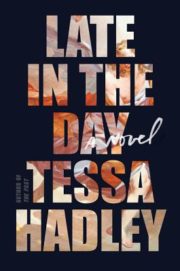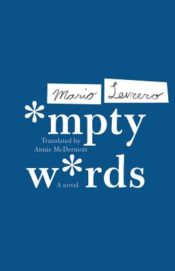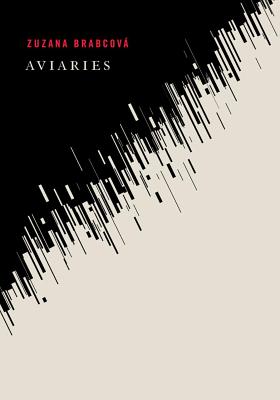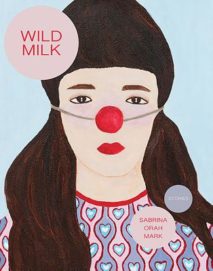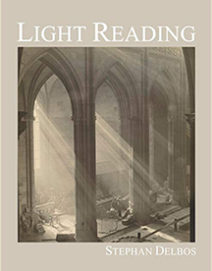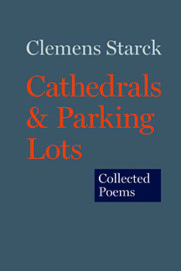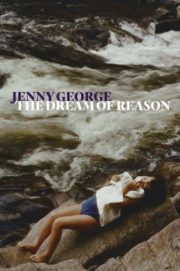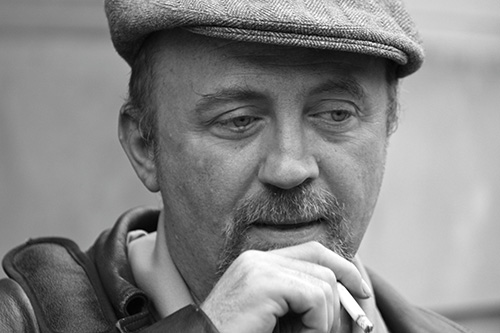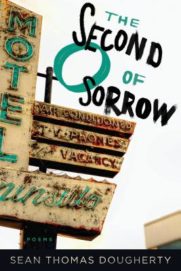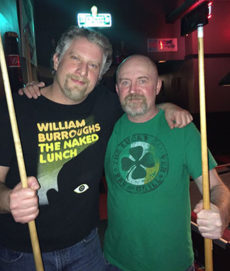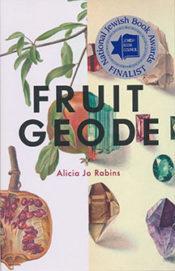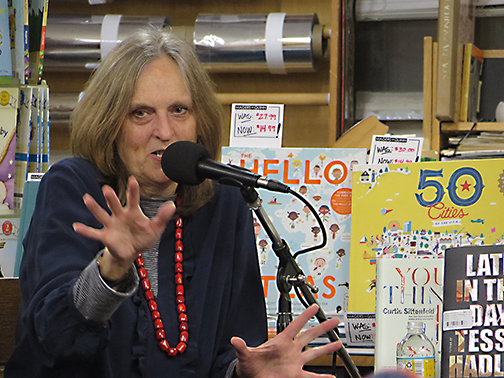
EDITOR’S NOTE: The evening of January 24, 2019 came with sub-zero temps in the Twin Cities, but that didn’t deter a dynamic crowd from attending Rain Taxi’s first literary event of the year: acclaimed British author Tessa Hadley in conversation with Minnesota’s own Curtis Sittenfeld, author of several works of fiction (most recently You Think It, I’ll Say It) and an avowed Hadley fan. The pair had a captivating chemistry, and offered attendees a lively discussion focused on Hadley's new novel, Late in the Day (Harper, $26.99)—though it also covers composition habits, novels vs. short stories, feminism in literature, and the teaching of writing, among other topics. The transcript below has been lightly edited for clarity.
Curtis Sittenfeld: I’m sure that there are some people in the room here who have read the book, or read the reviews—but in your own words, what do you feel this book is about?
Tessa Hadley: It’s about two marriages, I suppose. And about long marriages. Because it’s been dawning on me more and more—as my own marriage has lasted longer and longer— that if people stay together, marriages last for an extraordinarily time. My parents have been together for nearly sixty years. So we think that we’re hopeless now, with so many marriages ending in divorce, but the truth is that in the old days most marriages ended with a death, quite simply. So these decades of hanging on to one person, as they change, are something new. I use this metaphor in the book somewhere—it’s drawn from a folktale—where you grab your lover and you hold him and he holds you, while he metamorphizes. I think in the folktale the lover becomes a dragon and a lion, a strange beast: we recognize all of that in our husbands and partners, I’m sure. And they recognize it in us! So, that’s sort of where it began. Two couples though, not only one—because that’s so much more fun—and then I was thinking about doing wicked things with them, so that it isn’t always so A & B and C & D, but sometimes A & C, and B & D, and so on. And then I asked myself: what’s the biggest, most monstrous change I can inflict on these four, and it was to have one of them die. My original idea had been to run the novel chronologically. Always, first of all, my idea is to run an incredibly simple, narrative line—and then that often proves to be impossible. I felt that somehow it would be cheating the reader if my character died three-quarters of the way through. It would have been mean, it would’ve been a blow, and I’m not sure that the fabric of the novel would have taken it. So as soon as I thought that actually the nicest one of the four of them drops dead, I knew the book had to begin with that. And so it does.
CS: How many pages had you written before you realized that you had to start the story that way?
TH: None. This is all thinking in advance. I don’t know what you do, Curtis, but when I’m writing one novel I would always be kind of panicky if I didn’t have another one that I’m getting ready. Some of those getting-ready ones never come to anything. But I have to be getting ready.
CS: And is the getting-ready all just thinking, or are you taking notes?
TH: A few notes, but not very many.
CS: When you thought, I’m going to start another novel, did you have multiple getting-ready ideas to choose from?
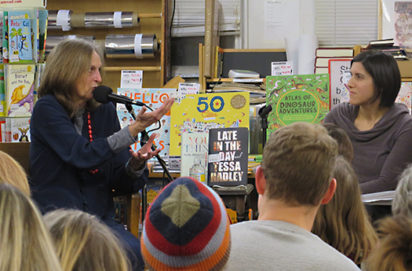 TH: No, this was the one. I probably had ten pages of notes, and bits of the people. And I’d been thinking, Well, that could happen, and then that… That’s the really thrilling creative time with a story, isn’t it? Before you’ve committed yourself to any words, or made anything that you’re then going to have to deal with as part of the fabric. Because you are just dreaming freely: and actually, you have lots of your best thoughts during that time. Do you recognize what I’m describing?
TH: No, this was the one. I probably had ten pages of notes, and bits of the people. And I’d been thinking, Well, that could happen, and then that… That’s the really thrilling creative time with a story, isn’t it? Before you’ve committed yourself to any words, or made anything that you’re then going to have to deal with as part of the fabric. Because you are just dreaming freely: and actually, you have lots of your best thoughts during that time. Do you recognize what I’m describing?
CS: Oh yeah, I think that a lot of times you can sort of cure yourself of wanting to write a story or novel by starting it. And discovering the huge discrepancy between what you imagine the quality to be, and what it is. If you were thinking about marriage as being longer, did you do any research, in terms of talking to friends or reading about marriage?
TH: No. I mean, because we just live it. What would you find out, by researching? Other stuff, I feel more guilty about not doing any research on. As for that thing that I said about marriages lasting such a short time on average in the past, I do know that’s a fact, but I didn’t find that through research; I read a history book about it twenty years ago, which just fascinated me for its own sake
CS: Because you’ve written several story collections and novels: How do you know if an idea is for a story or a novel?
TH: Well, it seems to me a short story ought to just come to you all at once—you may of course have to work it out a bit, just push it a little. Sometimes you might walk around thinking rather deliberately: I really need to write another short story. But your mind has a way of drying up when you give it that instruction. The right story usually comes sweetly, without trying too hard. On the plane from Seattle today, I got the whole of two characters—two sisters. They just delivered themselves as I looked down out of the window. Now I just need a little something to happen to them. But my two sisters can’t make a novel, I just know it. I think that the ideas for novels are more like sweated labor, I have to work harder at those. Like deciding I could make one out of those two couples. Almost I’m thinking, when I’m preparing a novel: how can I make something people will want to read? What’s fun? Which sounds like an awful thing to say about a book that begins with a death, and has got a lot of sadness in it. But in the end it’s got to be for fun, because reading novels is for pleasure. And pleasure, of course, comes in strange ways, and it comes from sad things: but in the end your role is to entertain and charm and beguile.
CS: As a reader, I can say it’s very charming and very entertaining. Regarding short stories vs. novels, do you enjoy writing one more than the other? Or do you feel any pressure from your publisher? Certainly in the U.S., any commercial publisher, or mainstream publisher—as opposed to independent publisher—would dramatically prefer that their writers pick novels, because they are much more widely purchased.
TH: And that’s true even more so in the U.K., because at least here in the U.S. you have some wonderful outlets for short stories—we have none. Well, next to none. We have Granta, which is now full of Americans anyway.
CS: Sorry!
TH: You’re just too damn good at them! It’s really not fair. But otherwise . . . almost nothing.
CS: Is writing stories something that you do for your own pleasure and writing novels something you do because your publisher wants them?
TH: I like both. Probably if I were more commercially-minded, then I would be writing more novels.
CS: Back to this particular novel . . . is there a section that you want to read that either would intrigue us or that captures the essence of it?
TH: This book actually hasn’t come out in the U.K. yet, so reading from it is really new for me. I’ve just done three readings so far; I haven’t even got to know how it sounds yet. Already, though, I can see that it’s very tempting to read the beginning over and over, but I’d like a change from that. I’ve already hinted that Zachary drops dead in the book’s opening pages. I’m going to read you from the second day. Friends and family are in absolute meltdown and shock, and they’ve all gathered at Christine and Alex’s home. They’ve invited Zachary’s wife Lydia to stay with them, his brother is staying with them, his daughter is staying with their daughter. The family and a few intimate friends have eaten together—they’ve managed to eat something for the first time in 48 hours. They’ve said words, but it’s still catastrophe-time. Christine and Alex, are Lydia and Zachary’s best friends, and as the book goes on we drop back to see the four of them together in their twenties, and then in their thirties, and then in their forties—so that we see lots of Zachary alive in the rest of the book. I’m going to read from a section where Christine and Alex—Lydia is asleep, or lying awake downstairs—are going to bed together on the first real night they’ve had since their friend’s sudden death.
(reads passage)
Hmm, I read you a very dark part of the book.
CS: Well, I feel like we can be your test run. There are shifting viewpoints in the book; do you feel like you have a favorite character?
TH: I don’t know that I have a favorite character, but maybe there’s one that I found most congenial to write, and it’s probably Christine. In some way she was natural and easy for me. I think I’ve done more with her than I have with the other three. Which one did I like best? I don’t even know. When you know people as intensely as I knew them from writing them and watching and studying them, then those judgements of liking and not liking fall away, don’t they?
CS: I do think that the question of whether a character is likeable comes up much more often among reviewers and readers who are not writers themselves. Do you agree with that?
TH: Yes, definitely.
CS: With the forthcoming paperback of my short story collection, there are discussion questions for reading groups, and I ghost-wrote some of them. And I wrote one that said something like: Do you think that Curtis Sittenfeld’s aim is for her characters to be likeable? I couldn’t believe that the publisher let me get away with it, but they did.
So the character of Christine, she’s a painter. I try not to do this, but I find it irresistible—whenever there’s a character who has some sort of artistic pursuit, it seems like so often, the description of that artistic pursuit could describe writing or the act of writing. Does her painting feel like a stand-in for writing for you personally or generally?
TH: Yes, to some extent. I wanted her to have that thing, that creative work, at the centre of her life. There’s a passage just before what I read, where she first hears the news of the death and she goes downstairs and locks up her studio and thinks that this has been the place that’s most important to her. Nobody else necessarily knows that about her; it’s private. I kind of have some of those same feelings about my desk. But at the same time, when you’re writing a book about a visual artist, you feel a responsibility to make that art work quite different from the work a writer does—as realistic-feeling as you can. So she isn’t a writer and she’s not me. But I was interested in a woman who was more and more drawn into doing her work and loving it. I was imagining this lovely, happy, fulfilled work and then this personal catastrophe just sort of smashing across that, seeming to spoil it.
CS: But the painting did feel very persuasive as itself, and also in terms of what it gave her emotionally—that resonated so much for me, that it comes from her but it’s so surprising and so consuming. I’m interested in the way you write about women. I think that all of your characters are three dimensional and have these rich inner lives. Somehow that can get conflated with feminism. Do you feel that your work is making a comment on women’s shifting roles? Obviously some of your characters have lived—maybe they were born in the ’50s or a lot has changed during their lifetime. Is there a way of summarizing what you are trying to say or do you feel that they are their own story and it’s not an essay or bumper sticker?
TH: It’s not an essay or a bumper sticker, but feminism is so interesting. How could one not have it filling out the world of the characters that I describe? My fascination is with men and women and their relationships, and women’s relationships together—for that matter, men’s relationships together, which I don’t feel nearly as expert in, though I’m just as interested in it. It’s true, I think that women struggle with writing men alone together, without women, actually.
CS: That’s interesting to think about. Are you familiar with the Bechdel test?
TH: Yes, I often think of it. It’s where you must have a scene with women alone together, without men present, and where the women aren’t talking about men.
CS: And the women have to be named, right? It’s a movie test, which a shockingly high proportion of movies fail.
TH: I think that I was consciously aware of that. My women do quite a lot of talking about men, I’m afraid. Partly because I notice that that’s what women do actually do, especially when they’re younger. Perhaps they get less interested as time goes on. We come to have other things to talk about.
CS: Before we turn over to the audience, I want to ask a few questions about the arc of your career. If I’m not mistaken, you were forty-six when your first book was published; I was reading some interviews with you and something you said was: “I wouldn’t change having had that twenty years of no one listening to me.” And then during those years when you were writing but maybe had not yet been published, you said this about writing: “I couldn’t do it and I couldn’t not do it.” When did you start trying to be published and how do you think it affected your perspective or the work itself?
TH: I always wanted to be a writer. And I think one has to have—and I don’t know if you agree with this, Curtis—a certain amount of insanity, to do it. An insane perseverance, against all of the thwarting and the failure and the flatness and deadness on the page that you talked about, when you‘re striving with a false idea. Only in my case, there were several whole books that I wrote for two years each: writing sort of secretly, slightly ashamedly and furtively. To my lovely family and friends, how embarrassing to say: I’m writing a novel. And then the novels were really no good, and in my heart of hearts somewhere all the time I was working on them, I knew that. And I knew nothing about publishing. I usually just sent the finished book to one publisher —and when they sent back a form letter that says something like: we do not think you are suitable for our list, I would just think: “No, I know. The book was awful, you’re right, and I won’t try and do it again.” And then I would give up for awhile, until I was seized again by the insanity of feeling I had to have another try, start over. If I wanted to diagnose myself, I would say that I’m very impressionable and I’m easily in love with other writers’ work. I was trying to write other writers’ books. Some novelists begin so young with their own strong stamp, which is brilliant. That wasn’t how I was. So I tried to write other people’s books: and therefore there are some terrible wrong novels of mine rotting in landfill somewhere.
CS: How recently have you looked at any of those books?
TH: Oh they’re gone. They are really in landfill.
CS: Really?
TH: Yes.
CS: Because I feel like the fact that one publisher turned them down, doesn’t—
TH: No, but I knew. The books were awful.
CS: Did you have some breakthrough? Was it Accidents in the Home, the first one that was published, or . . . ?
TH: I went on a writing course. Like an MFA. I was very skeptical and scornful of courses. I thought, no writer I respect has ever been on a writing course. But I also thought, I must have a watershed, I must test this thing, because if I just carry on failing I’m going to have a very miserable life. So, I applied to study for a Creative Writing MA. And it’s true that nobody can teach you to write, nobody taught me to write. But something about having a real audience at last—instead of thinking vaguely I want to be Tolstoy, or J. M. Coetzee, or Nadine Gordimer, and writing for no one—that was crucial. Suddenly, I was writing for five people on Thursday, and—it sounds so banal, but I was asking myself: What would they like? What would be fun to read to them? It was as if I took control of my material, on my own terms, in some way. Also, there’s a degree of competitiveness. I would think, oh she was good last week. . . . I can do that better. Anyway it was a wonderful year, and I loved it.
CS: It was just one year?
TH: It was an MA, just one year. And the book I wrote that year was a hybrid, so it was actually all over the place, not a success in itself. But at last I was writing little passages which I knew were much better. And I was writing some short stories too—actually I still had no clear idea of how to write a novel, but I seemed to be able to get somewhere with the short stories. So I thought: what if I wrote a succession of short stories, about the same people, in chronological order? I had learned how to achieve that sprung tension that holds a short story together, makes something happen. Also, I learned how to be in control. I could think: make this better. Make something happen, twist things around at the end. Until then I had almost written as if I was reading the books I was writing, wondering what was going to happen next. That’s no good, is it? It’s your book, you’ve got to decide, you’ve got to make something happen. It’s up to you to take charge.
CS: If I’m not mistaken, you were pretty quickly teaching in the program where you had been a student. Are you still teaching there?
TH: I am, but I am going to retire. I’ve done it for about twenty one years now.
CS: And have you enjoyed the experience? None of us will tell, we’re far away from—
TH: I have loved it. When I first worked there, I was teaching literature rather than creative writing. I loved that. One of my thoughts, at the end of the MA - because I still hadn’t written anything that was right yet, although I was more hopeful—I thought: this is going to make me miserable if I go on failing, so let’s try doing the other thing that’s so much easier. Let’s teach literature. And I had a joyous time teaching undergraduates about all the books I loved.
CS: And then how long did you do that until you started teaching creative writing?
TH: For years I did both, and then I began cutting back the literature teaching, simply to have more time for my own writing.

